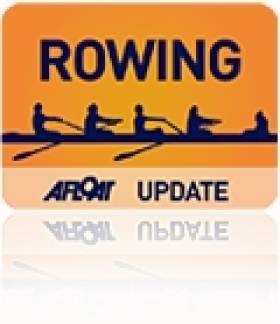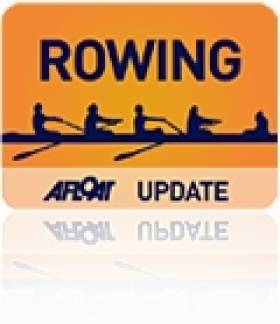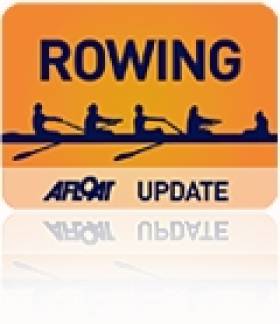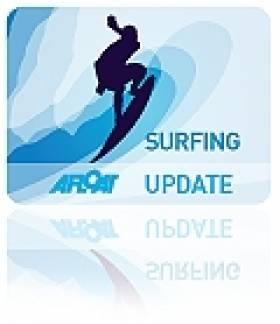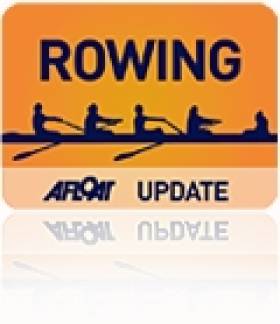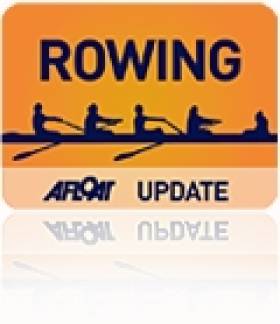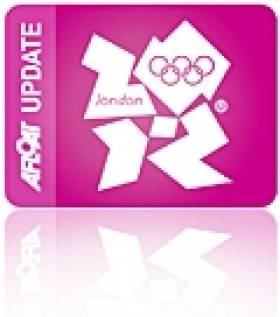Displaying items by tag: World Cup
Ireland Women's Crews Qualify for A Finals at World Cup
# ROWING WORLD CUP: Claire Lambe in the lightweight single sculls and the double scull of Leonora Kennedy and Monika Dukarska both won their repechages to progress to A Finals at the World Cup regatta at Dorney Lake today.
Lambe had missed out on direct qualification through her heat when finishing third, but she made certain of an A Final place by leading from the early stages in her second-chance race. Ka Man Lee from Hong Kong was the only serious test for Lambe. She finished second and also qualified for the final.
The double had a very satisfying victory in only their second race as a crew. They were pressed at the end by Finland, but led through all four quarters.
World Cup Regatta, Dorney Lake, Day One (Irish interest)
Men
Lightweight Single Sculls - Heat Two (First Two Directly to A/B Semi-Final; rest to Repechage): 1 Ireland (P O’Donovan) 7:13.89, 2 New Zealand (D Grant) 7:17.37; 3 Hong Kong 7:27.67, 4 Korea 7:28.71, 5 Brazil Two 7:30.92, 6 Japan 7:32.49.
Lightweight Double Sculls – Heat One: 1 Britain (R Chambers, P Chambers) 6:29.86.
Single Sculls – Heat Three: Britain (A Campbell) 7:07.03.
Arms and Shoulders Single Sculls – Heat One (First Directly to Final; rest to Repechage): 4 Ireland (T Kelly) 6:31.23.
Women
Double Sculls – Heat Two (First Two Directly to A Final; rest to Repechage): 1 Britain (F Houghton, V Meyer-Laker) 6:59.96, 2 China Two (D Xu, F Pan) 7:03.91; 3 Ireland (M Dukarska, L Kennedy) 7:15.68, 4 Korea 7:18.48. Repechage (Two to A Final; rest to B Final): 1 Ireland 7:12.18, 2 Finland 7:12.92; 3 China Three 7:16.23, 4 Korea 7:18.27, 5 China One 7:32.84.
Lightweight Single Sculls – Heat Two (First Two Directly to A Final; rest to Repechage): 1 Brazil (F Beltrame) 7:54.85, 2 Britain (R Walczak) 7:59.13; 3 Ireland (C Lambe) 8:07.80, 4 Paraguay 8:29.68, 5 Hong Kong 8:34.62. Repechage (Two to A Final; rest to B Final): 1 Ireland (Lambe) 8:05.22, 2 Hong Kong One 8:07.29; 3 Paraguay 8:18.51, 4 Austria Two 8:23.09, 5 Singapore 8:28.71, 6 Hong Kong 8:35.40.
Kennedy and Dukarska Set for World Cup Repechage
# ROWING WORLD CUP: Ireland’s new double scull of Leonora Kennedy and Monika Dukarska finished third in their heat, one place away from direct qualification for the A Final at the World Cup regatta at Dorney Lake today. Britain won the heat well, and China’s second crew kept Ireland at bay for the second spot. Ireland are set for a repechage this afternoon.
World Cup Regatta, Dorney Lake, Day One (Irish interest)
Men
Lightweight Single Sculls - Heat Two (First Two Directly to A/B Semi-Final; rest to Repechage): 1 Ireland (P O’Donovan) 7:13.89, 2 New Zealand (D Grant) 7:17.37; 3 Hong Kong 7:27.67, 4 Korea 7:28.71, 5 Brazil Two 7:30.92, 6 Japan 7:32.49.
Arms and Shoulders Single Sculls – Heat One (First Directly to Final; rest to Repechage): 4 Ireland (T Kelly) 6:31.23.
Women
Double Sculls – Heat Two (First Two Directly to A Final; rest to Repechage): 1 Britain (F Houghton, V Meyer-Laker) 6:59.96, 2 China Two (D Xu, F Pan) 7:03.91; 3 Ireland (M Dukarska, L Kennedy) 7:15.68, 4 Korea 7:18.48.
Lightweight Single Sculls – Heat Two (First Two Directly to A Final; rest to Repechage): 1 Brazil (F Beltrame) 7:54.85, 2 Britain (R Walczak) 7:59.13; 3 Ireland (C Lambe) 8:07.80, 4 Paraguay 8:29.68, 5 Hong Kong 8:34.62.
O'Donovan (19) Marks World Cup Debut With Heat Win
# ROWING WORLD CUP: Paul O’Donovan gave Ireland lift-off at the World Cup Regatta at Dorney Lake this morning. The 19-year-old UCD student, making his World Cup debut, won his heat of the lightweight single sculls to qualify directly for the Semi-Finals. Duncan Grant of New Zealand, the red-hot favourite, took the second qualification place.
Claire Lambe will have to travel the repechage route after a third-place finish in her heat of the lightweight single sculls. With Fabiane Beltrame of Brazil winning well, direct qualification for the A Final rested on taking the second place. Ruth Walczak of Britain grabbed her chance.
Tom Kelly finished fourth in the heat of the Arms and Shoulders single sculls.
World Cup Regatta, Dorney Lake, Day One (Irish interest)
Men
Lightweight Single Sculls - Heat Two (First Two Directly to A/B Semi-Final; rest to Repechage): 1 Ireland (P O’Donovan) 7:13.89, 2 New Zealand (D Grant) 7:17.37; 3 Hong Kong 7:27.67, 4 Korea 7:28.71, 5 Brazil Two 7:30.92, 6 Japan 7:32.49.
Arms and Shoulders Single Sculls – Heat One (First Directly to Final; rest to Repechage): 4 Ireland (T Kelly) 6:31.23.
Women
Lightweight Single Sculls – Heat Two (First Two Directly to A Final; rest to Repechage): 1 Brazil (F Beltrame) 7:54.85, 2 Britain (R Walczak) 7:59.13; 3 Ireland (C Lambe) 8:07.80, 4 Paraguay 8:29.68, 5 Hong Kong 8:34.62.
20 Countries (including IRL) for Wakeboard World Cup
Founded by a representative of the Sultan of Brunei in 1827, Kuching City is the largest on the exotic island of Borneo. Ireland is in the line up with Sian Hurst and David O'Caoimh. This tropical location, with the support of the Sarawak State Government represented by the Ministry of Tourism and Heritage, Sarawak, will host this 31st World Cup Stop of the International Waterski & Wakeboard Federation (IWWF) and Waterski & Wakeboard World Cup Sdn.Bhd. Initial event details were released at a Press Conference last January in Kuching and all preparations have now been completed.
The IWWF World Cup Series was established to bring the very best Waterski and Wakeboard athletes to important high population centres around the world. To date these have included London, Paris, Alexandria, Moscow, Beijing, Singapore, Doha, Liuzhou, Chuncheon, Putrajaya, and many others. Following this Kuching Wakeboard World Cup Stop, it will move on to Linyi in China.
This Stop will include Wakeboard and the Stars of Florida, a spectacular Show Ski Team from Florida, USA. They will join the Malaysia Day Celebrations in a water parade on the Sarawak River on the night of September 16th which will culminate with riverside fireworks displays.
Not only has this Kuching World Cup Stop been scheduled to coincide with the Malaysia Day celebrations, it will also form part of the birthday celebrations of the Governor TYT Yang Di-Pertua Negeri Sarawak. For the first time it will also be staged in conjunction with the historic 2011 Sarawak Regatta right in the centre of Kuching City. Dating back to 1872, the Regatta attracts an enormous variety of colourful boats including Dragon Boats, Long Boats, etc. During the four days involved, over 100,000 spectators are expected, plus 400 boats 6,000 paddlers - and of course the very best World Cup Wakeboard Riders from 20 countries. The unique combination promises to make this one of the most spectacular World Cup Stops to date.
The special MasterCraft X2 Wakeboard competition boat has already arrived in the Port of Kuching and will play its vital part throughout the World Cup Stop on the Sarawak River.
For those not fortunate enough to be able to attend the 2011 celebrations in Kuching, they will nevertheless be able to enjoy both a FREE STREAM live Webcast from the waterfront and also replays after the event. The time zone is GMT + 8 hours. The Webcast Links are as follows :
LIVE :
http://247.tv/waterski/freestream/2011-sarawak-wakeboard-world-cup/
LIVE REPLAYS :
http://247.tv/waterski/2011-sarawak-wakeboard-world-cup/
Following this Kuching World Cup Stop, the IWWF will distribute an edited TV highlights show to over 500 million viewers and Media Releases to 192 countries. Both Kuching City and this 31st World Cup Stop on September 15/18 will give a great insight to both the special attractions of Sarawak and the extraordinary skills of the World Cup Riders.
The local times of the Wakeboard World Cup programme are as follows :
(GMT+8hrs) :
September 16th - FRIDAY
07.30 - 11.30hrs
Wakeboard - Practice & Semi-Finals
September 17th - SATURDAY
08.00 - 11.30HRS
Wakeboard - Sarawak Youths / Men Quarter Finals / Women LCQ
15.30 - 16.30hrs
Wakeboard - Men LCQ
17.00 - 17.45hrs
Stars of Florida Ski Show
September 18th - SUNDAY
09.00 - 10.00hrs
Wakeboard - Men Semi-Finals
10.00 - 11.00hrs
Wakeboard - Women Finals
11.00 - 11.45hrs
Stars of Florida Ski Show
12.00 - 13.00hrs
Wakeboard - Men Finals
15.000 - 15.45hrs
Stars of Florida Ski Show
16.00 - 17.00hrs
Medals Presentation on sit
Ireland Women's Double Finishes Eleventh at World Cup
Ireland’s Lisa Dilleen and Sanita Puspure finished fifth in the B Final of the women’s double scull at the World Cup rowing regatta in Lucerne. This places the Irish 11th overall. Belarus and the United States were the two top crews down the course with Belarus striking for the finish first and taking first. The race featured four of the crews which competed in the A Final at Munich, where Dilleen and Puspure also finished fifth.
World Cup Regatta, Lucerne – Day Three (Irish interest)
Women
Double Scull – B Final (Places 7 to 12): 1 Belarus 7:03.19, 2 United States 7:04.44, 3 Italy 7:08.71, 4 Romania 7:09.08, 5 Ireland 7:10.29, 6 China 7:14.83.
Ireland So Close to Second Medal at Lucerne World Cup
Ireland came within 1.38 seconds of adding a second bronze medal to Siobhan McCrohan's at the World Cup rowing regatta at Lucerne today. The lightweight quadruple scull of Shane O’Driscoll, Niall Kenny, Peter Hanily and Justin Ryan were passed in the closing stages by Denmark when they seemed set to take third in this A Final. Germany won the race, with Italy second.
World Cup Regatta, Lucerne – Day Two (Irish interest)
Men
Lightweight Quadruple Scull – A Final: 1 Germany 6:03.19, 2 Italy 6:05.84, 3 Denmark 6:07.28; 4 Ireland 6:08.66, 5 Switzerland 6:09.61, 6 Norway 6:18.37.
Lightweight Double Scull – D Final (places 19 to 24): 1 Hungary 6:36.15, 2 Ireland 6:43.77, 3 Sweden 6:44.75.
Women
Double Scull – Semi-Final (First Three to A Final; rest to B Final): 1 Australia 6:54.22, 2 Ukraine 6:56.73, 3 Poland 6:58.30; 4 Belarus 7:07.73, 5 Romania 7:09.95, 6 Ireland (L Dilleen, S Puspure) 7:15.75
Lightweight Double Scull – C Final (Places 13 to 18): 1 Austria 7:14.01; 5 Ireland (S Dolan, C Lambe) 7:19.47
Lightweight Single Scull – Semi-Final One (First Three to A Final; rest to B Final): 1 Switzerland (P Weisshaupt) 7:56.1, 2 Ireland (S McCrohan) 7:58.65, 3 Belgium (J Hammond) 8:03.22; 4 Japan 8:09.31, 5 Canada 8:09.80, 6 Hong Kong 8:14.50. A FINAL: 1 Greece (A Tsiavou) 7:47.78, 2 Switzerland (P Weisshaupt) 7:51.39, 3 Ireland (S McCrohan) 7:54.86; 4 Belgium (J Hammond) 7:55.17, 5 Poland 7:59.80, 6 Netherlands (M-A Frenken) 8:02.57.
Dilleen and Puspure Hit by Poor Start in Lucerne
Ireland’s women’s double of Lisa Dilleen and Sanita Puspure have had to settle for a place in the B Final at the World Cup rowing championships in Lucerne. In their semi-final they missed strokes after catching a buoy near the start and were never contenders for one of the top three places which would have sent them into the A Final.
World Cup Regatta, Lucerne – Day Two (Irish interest)
Men
Lightweight Double Scull – D Final (places 19 to 24): 1 Hungary 6:36.15, 2 Ireland 6:43.77, 3 Sweden 6:44.75.
Women
Double Scull – Semi-Final (First Three to A Final; rest to B Final): 1 Australia 6:54.22, 2 Ukraine 6:56.73, 3 Poland 6:58.30; 4 Belarus 7:07.73, 5 Romania 7:09.95, 6 Ireland (L Dilleen, S Puspure) 7:15.75
Lightweight Double Scull – C Final (Places 13 to 18): 1 Austria 7:14.01; 5 Ireland (S Dolan, C Lambe) 7:19.47
Lightweight Single Scull – Semi-Final One (First Three to A Final; rest to B Final): 1 Switzerland (P Weisshaupt) 7:56.1, 2 Ireland (S McCrohan) 7:58.65, 3 Belgium (J Hammond) 8:03.22; 4 Japan 8:09.31, 5 Canada 8:09.80, 6 Hong Kong 8:14.50.


























